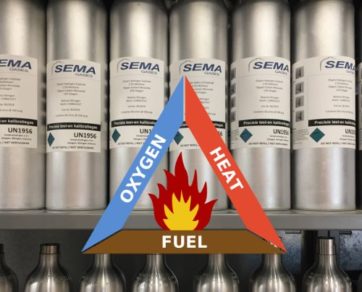How do you take a gas sample in confined spaces? a question we do receive quite often, so how do you do it and what exactly is a confined space? Confined spaces are spaces with limited entry and egress and are in the first instance not suitable for humans. But on some occasions for example, at storage tanks, marine vessel tanks or tunnels you have to take gas samples before or during entering these confined spaces. So, how do you take a gas sample in confined spaces?
What is a confined space?
A confined space is a space with limited entry not intended for a human to be permanent. Examples of confined spaces are storage tanks, marine vessel tanks, sewers and manholes, railcar tanks, tunnels, agriculture silos, etc. A confined space will be temporarily entered by workers for maintenance. The atmosphere in confined spaces often contains harmful gases. Before entering a confined space, the atmosphere inside must be tested with gas detection equipment.
What are most common gases to be expected in a confined space?
Oxygen: The ideal oxygen level is 20.9% Vol. This is the oxygen level which is the standard level in normal air and in which a person can breathe well. The minimum permissible oxygen level is 19.5% Vol. An oxygen level lower than 19.5% Vol. that continues to decline causes serious effects such as less ability to work continuously, less coordination, less judgement, blue lips, mental failure, unconsciousness, coma or finally death. An oxygen level higher than 23.5% Vol. causes an extreme fire hazard.
Combustible gas: Combustible gases are gases which can cause an explosion when they are in a mixture with a certain level of air. The lowest mixture of combustible gas and air which can cause an explosion is called the lower explosive limit (LEL). Concentrations lower than LEL are too lean to explode. The highest mixture of combustible gas and air which can cause an explosion is called the upper explosive limit (UEL). Concentrations higher than the UEL are too rich to explode. For causing an explosion not only a mixture of combustible gas and air but also heat or a source of ignition is needed.
Toxic gas: Most common toxic gases that could be present in confined spaces are carbon monoxide (CO) and hydrogen sulfide (H2S). However, there are numerous of toxic gases that could be present in confined spaces. Toxic gases should be below the OSHA permissible exposure limit.
How to take a gas sample?
For taking a gas sample, a portable multi-gas detector with internal pump and gas sampling accessories such as long sampling hose and a float type sampling probe is needed. The portable multi-gas detector should contain internal sensors for oxygen, combustible gases (measuring in %LEL and/or Vol%) and toxic gases carbon monoxide (CO) and hydrogen sulfide (H2S. If the portable multi-gas detector is also equipped with a PID sensor numerous of other toxic gases can be detected. For taking a gas sample in confined spaces of marine vessels the sampling hose length could be up to 30 meters.
It is important to take gas samples in various levels in the confined space (at the top, middle and bottom) because every level contains different gas concentrations. Gases with a high concentration are usually at the top or at the bottom of the confined space. Gases with a lower concentration are present throughout the confined space. When the gas sampling in the confined space has been completed and the atmosphere in the confined space is safe for entering one or more persons could enter the confined space.
How to enter the confined space?
Persons entering a confined space should always carry a small personal multi-gas detector with internal sensors for oxygen, combustible gases and toxic gases carbon monoxide (CO) and hydrogen sulfide (H2S) which is continuously monitoring the inside atmosphere. The inside atmosphere in a confined space could always change, and therefore continuous monitoring of the inside atmosphere during a stay in the confined space is of vital importance.



